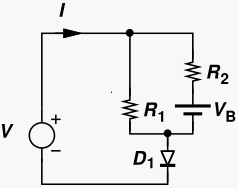Analog Circuits Interview Questions :-
1. What are linear ICs?
A linear integrated circuit is a solid state analog device characterized by a theoretically infinite number of possible operating states. It operates over a continuous range of input levels. Within a certain input range, the amplification curve of a linear IC is a straight line i.e. the input and output voltages are directly proportional. The best known common linear IC is the operational amplifier or op amp.
2. What is lock range and capture range of PLL?
Lock Range- The lock range of a PLL is the range of the input frequencies about the centre frequency for which the loop maintains a lock. The lock range is always symmetrically located with respect to the centre frequency of the voltage controlled oscillator (VCO).
Capture Range- The capture range is the range of input frequencies for which the initially unlocked loop will lock on an input signal. The capture range is always less than the lock range. The capture range denotes the transient condition. The capture range also is symmetrically located with respect to the centre frequency of the voltage controlled oscillator (VCO).
3. Why IC 555 timer is called so?
IC 55 timer is called so because in this 3 resistors of 5k ohm each are used.
4. For the analysis of binary weighted resistor network, we use Millman’s theorem what is it?
Millman’s theorem states that the voltage appearing at any node of resistive network is equal to the summation of the conductances connected to that node.
5. What is accuracy.
Accuracy indicates how close the analog output voltage is to its theoretical value. In short it shows the deviation of actual output from the theoretical value.
6. Why square wave generator is called as free running or astable multivibrator?
If output is not stable then multivibrator is called as astable or free running multivibrator and since square wave is not stable, therefore square wave generator is called as free running or astable multivibrator.
7.What are hybrid IC’s?
In hybrid IC’s, passive components (such as resistors and capacitors) and the interconnections between them are formed on an insulating substrate. Active components such as diodes and transistors, as well as monolithic integrated circuits are then connected to form a complete circuit.
8. Why the diode op-amp combination is referred to as a super diode?
Placing the diode in the feedback loop eliminates any error that would have otherwise raised due to the forward voltage drop of the diode. Hence the diode op-amp combination is referred to as a super diode.
9. What is Hysteresis or backlash for a comparator?
The Hysteresis or backlash for a comparator comes into existence when positive feedback is used. It is defined as the difference between the ‘turn –on’ and ‘turn-off’ input voltage. Due to hysteresis, the comparator output makes transitions at different points when it changes its state from low to high and high to low state.
10. How does an oscillator operate without an input signal?
Due to random movement of electrons inside any electronic device such as resistor, a voltage is generated which is called as noise voltage. This noise voltage is amplified by the amplifier and feedback. If the Barkhausen criterion is satisfied then, sustained oscillations will be obtained at the output. Thus noise voltage acts as the starting voltage and oscillators can operate without an input signal.

11. Define full power bandwidth.
It is defined as the maximum frequency at which the op-amp will yield an undistorted ac output with the largest possible signal amplitude. The amplitude is dependent on the type of op-amp and the power supplies.
12. What are the parameters that should be considered for DC applications?
The parameters that should be considered for DC applications are-
- Input and output resistance.
- Output voltage swing.
- Input offset voltage and current.
- Large signal voltage gain.
13. Why op-amp is not used as an amplifier in the open loop configuration?
In practice the open loop op-amp is not used due to the following reasons-
- Due to very large open loop gain, distortion is introduced in the amplified output signal.
- The open loop gain does not remain constant. It varies with changes in temperature and power supply.
- The bandwidth of an op-amp in the open loop mode is very small almost zero. This is the reason why, the open loop op-amp is not used in practice as an amplifier.
- However the op-amp in open loop configuration is used in applications such as comparators (both inverting and non inverting comparators).
14. What is the advantage of using a constant current bias circuit?
Constant current bias circuit supplies constant emitter current. It also provides very high source resistance since the AC equivalent of the DC current source is ideally an open circuit.
15. What is the use of level translators?
Because of direct coupling, dc level at the emitters rises from stage to stage. This increase dc level tends to shift the operating point of the succeeding stage and therefore limits the output voltage swing a may even distort the output signal. So to increase this dc level, level translator circuits are used.